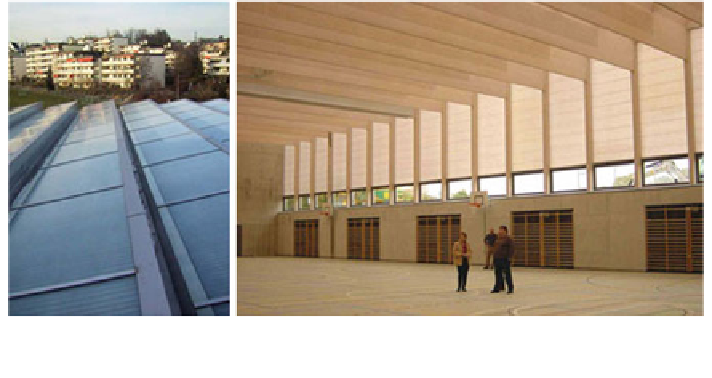Civil Engineering Reference
In-Depth Information
Fig. 9 The school Buchwiesen in Zurich: example of the use of granular-aerogel-filled
Scobatherm glass fibre composite panels in the form of a transparent daylighting roof (2003)
called Scobatherm consists of an aerogel-granulate-filled glass-fibre-reinforced
polyester resin composite profile (Scobalit AG 2012). One of its first uses in a
building for daylighting is the roof construction of the school ''Buchwiesen'' in
Zurich in 2003 (Fig.
9
).
Aerogel glazings, vacuum glazings, new spacer materials and solutions, and
electrochromic windows currently seem to have the largest potential in fenestra-
tion products (Jelle et al.
2012
). At the moment, different commercial systems with
granular translucent aerogels are available on the market, offering excellent
thermal performance, a good solar heat gain, and a good sound insulation:
1. structural composite panels for skylights and façades;
2. polycarbonate systems for skylights and façades;
3. U-channel glass (self-supporting systems of glass channels with an extruded
metal perimeter frame);
4. insulated glass units; and
5. tensile structures and roofing.
In Europe, EMB Products AG, Germany (Roda
2012
), developed multiwall
polycarbonate systems filled with Lumira
TM
aerogel for use in façades, separation
walls, curtain walls, and roofs; the U-values vary in the 0.48-1.30 W/m
2
K range
(Fig.
10
), depending on the thickness of the system (16-50 mm).
Other structural polycarbonate systems are proposed by Alcaud Sa and
Skydome (France); Xtralite for roof solutions (UK) in Europe; and Wasco, Solar
innovations, Duo-Gard, Crystallite, and Aerolenz (skylights) in the USA (Xtralight
Rooflight
2012
).
Structural composite panels are manufactured by Stoakes systems (UK)
(Stoakes Systems 2013), Scobatherm (Switzerland), and Kallwall (USA) (Kalwall
Corporation 2013) (Fig.
11
a).

